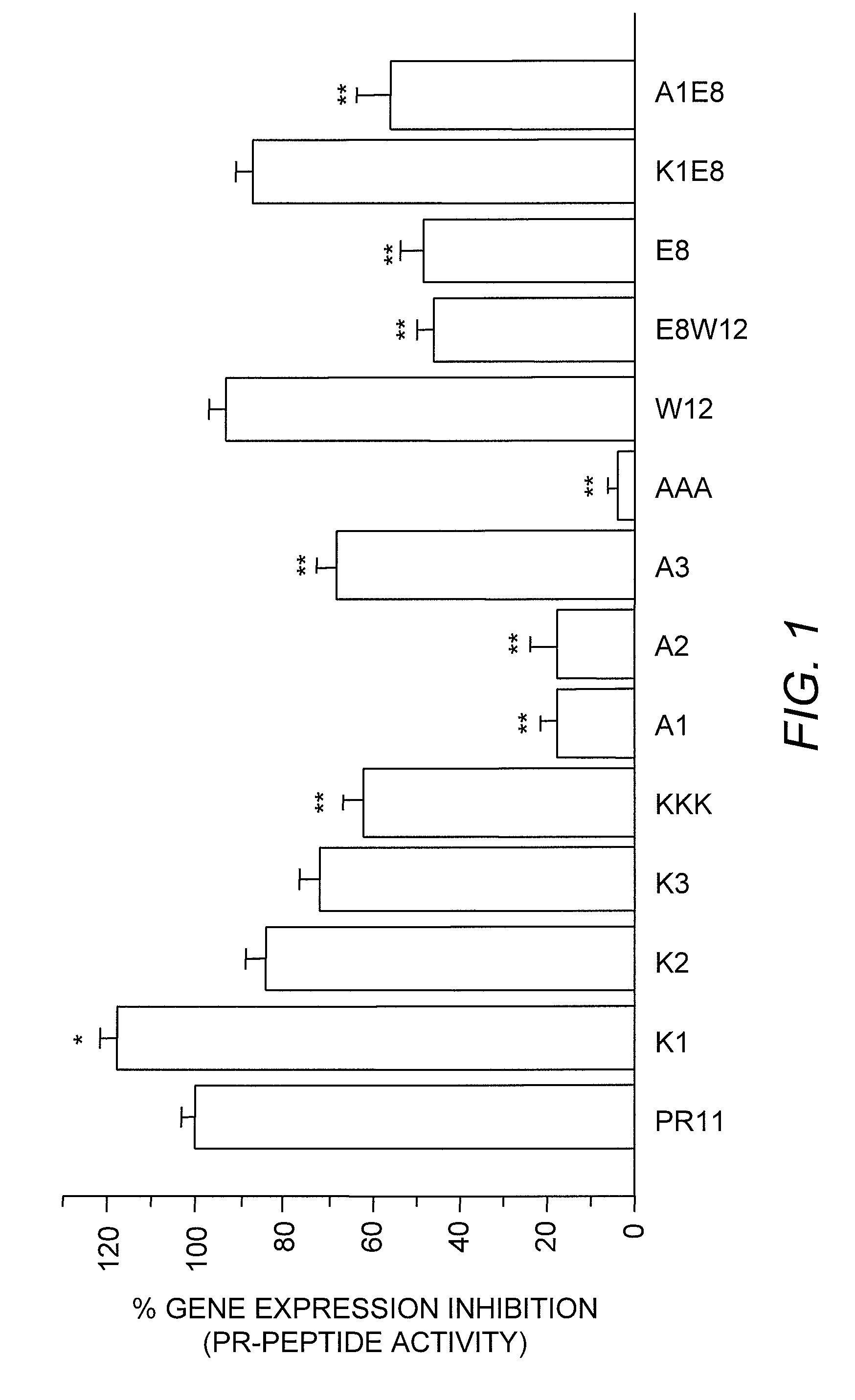Mutant proline-and-arginine rich peptides and methods for using the same
a technology of arginine and proline, which is applied in the direction of peptides, endopeptidases, peptides/protein ingredients, etc., can solve the problems of triggering apoptosis, triggering apoptosis, and insufficient explanation of the selective inhibition mechanism, so as to inhibit the activity of mammalian 20s proteasome and modulate expression
- Summary
- Abstract
- Description
- Claims
- Application Information
AI Technical Summary
Benefits of technology
Problems solved by technology
Method used
Image
Examples
example 1
Materials and Methods
[0055]Proline-and-Arginine Rich Peptides. The amino acid sequence of chemically synthesized PR-peptide used the porcine PR39 sequence: NH2-RRRPRPPYLPRPRPPPFFPPRLPPRI PPGFPPRFPPRFP-COOH (SEQ ID NO:1). Synthetic PR39, PR11 (RRRPRPPYLPR; SEQ ID NO:2), and AAA-PR11 (AAAPRPPYLPR; SEQ ID NO:3) were purchased from C S Bio Inc. (San Carlos, Calif.) or Genemed Biotechnologies, Inc. (South San Francisco, Calif.). All other peptides were obtained from the Tufts Core Facility (Boston, Mass.). All peptides used herein were HPLC-purified and dissolved in phosphate-buffered saline. Peptide concentrations were determined using the molar extinction co-efficient (1280 M−1 cm−1 at 280 nm) of the single tyrosine residue.
[0056]Mutant Peptides. The mutant PR11 peptides synthesized and analyzed herein are listed in Table 2
[0057]
TABLE 2PeptideMutant PeptideSEQ IDNameSequenceNO:W12RRRPRPPYLPRW4K1KRRRPPYLPR5K1E8KRRPRPPELPR6K2RKRPRPPYLPR7K3RRKPRPPYLPR8KKKKKKPRPPYLPR9A1ARRPRPPYLPR10A1E8ARR...
example 2
20S-Inhibitory Activity of Mutant PR Peptides
[0064]The chymotrypsin-like activity of mammalian 20S proteasome is inhibited by the proline-and-arginine-rich peptide, PR39, and its N-terminal fragment, PR11. AAA-PR11, in which the first three arginines are mutated to alanines, is not an inhibitor of 20S. To elucidate amino acids within PR11 that are essential for the 20S inhibiting activity and to establish correlation between the 20S-inhibiting activity and action along the NF-κB pathway, systematic structure-function analyses were conducted. Some peptides in which Tyr8 was mutated to a non-aromatic residue were designed to contain an added 12th residue, tryptophan, for ease of peptide quantification. The addition of Trp12 did not significantly alter the PR11 activity in 20S enzymatic activity assays. This indicates that either the Trp12 does not interfere with PR11 interaction with 20S proteasome or that Trp12 provides a hydrophobic contact that might be similar to Pro12 in PR39.
[00...
example 3
PR11 Regulation of NF-κB-Related Gene Expression
[0073]NF-κB is a key component of the inflammatory pathway. It has been shown that PR39 acts as an anti-inflammatory agent by inhibiting degradation of IκBα, thereby inhibiting NF-κB activity (Gao, et al. (2000) J. Clin. Investig. 106:439-448, Bao, et al. (2001) Am. J. Physiol. Heart Circ. Physiol. 281:H2612-H2618). However, the identification of genes that are altered by PR11 and the extent of PR11s effect on genes which regulate the NF-κB signaling pathway have remained unknown. It was posited that the inhibition of IκBα degradation by PR11 might affect the expression of upstream genes regulating the NF-κB pathway activity and that the magnitude of that effect would correspond to the extent of IκBα degradation inhibition by PR11 and its analogs. Hence, using an NF-κB-specific microarray, changes in the expression of genes regulating the NF-κB pathway were investigated in endothelial cells which were induced by PR11 or its mutants.
[00...
PUM
| Property | Measurement | Unit |
|---|---|---|
| pH | aaaaa | aaaaa |
| dihedral angles | aaaaa | aaaaa |
| hydrophobic | aaaaa | aaaaa |
Abstract
Description
Claims
Application Information
 Login to View More
Login to View More - R&D
- Intellectual Property
- Life Sciences
- Materials
- Tech Scout
- Unparalleled Data Quality
- Higher Quality Content
- 60% Fewer Hallucinations
Browse by: Latest US Patents, China's latest patents, Technical Efficacy Thesaurus, Application Domain, Technology Topic, Popular Technical Reports.
© 2025 PatSnap. All rights reserved.Legal|Privacy policy|Modern Slavery Act Transparency Statement|Sitemap|About US| Contact US: help@patsnap.com

